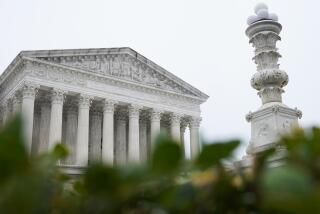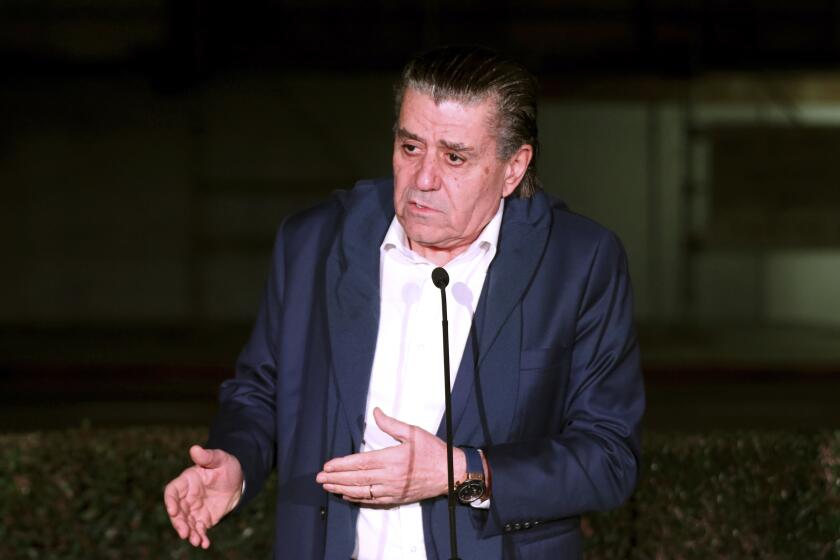Israelis Slay 19 Arabs in Clash in Jerusalem : Uprising: Incident is the worst in three years of unrest. Crowd stones Jews worshiping at Western Wall.
Israeli police Monday shot and killed at least 19 Palestinians who were raining down stones on Jews worshiping in Jerusalem’s Old City, in the worst outburst of violence in nearly three years of the Palestinian uprising.
About 150 other Palestinians were wounded in the bout of civil unrest, which was on a scale with the most serious in decades of Jewish-Arab strife.
The site of the incident was the Temple Mount, known to Muslims as the Haram al Sharif, or noble sanctuary. Jews revere it as the site of the Second Temple, destroyed in Roman times, and Muslims believe it is the place where the Prophet Mohammed ascended to heaven.
About 3,000 Palestinians had massed there amid reports that a fundamentalist Jewish group was preparing to lay a foundation stone for a new temple in the enclosure where the Dome of the Rock, Islam’s third-holiest shrine, is situated.
The Jewish group, the Faithful of the Temple Mount, had been barred by Israel’s Supreme Court from entering the enclosure. Nonetheless, the Palestinians hurled stones at worshipers at the Western Wall, which is adjacent to and below the Temple Mount.
Arabs contended that police fired tear gas before any stones were thrown, but police officers and neutral observers insisted that the rocks were thrown without provocation.
The Palestinians burned a police post on the Temple Mount as municipal and border police stormed the site, firing tear gas, rubber-coated pellets and lead bullets.
As panicked Jewish worshipers were evacuated by bus, ambulances moved in to evacuate the Arab dead and wounded. Smoke from burning tires enveloped the Old City and adjacent neighborhoods, creating an atmosphere of war. There were nightmarish scenes of mourning and despair at two hospitals on the nearby Mount of Olives.
In Washington, Secretary of State James A. Baker III chided Israel for using what he said was excessive force, but he said the United States has not yet been able to determine which side was responsible for the confrontation. He noted that Israeli authorities and Palestinians were both accusing the other of provocation.
“We do not have all the facts, but it is fair to say that Israel needs to be better prepared and able to exercise restraint in handling disturbances of this nature,” Baker said. “This tragic loss of life is obviously a cause for great sadness.”
Baker flatly rejected a suggestion by French President Francois Mitterrand that the incident inevitably links the Arab-Israeli dispute with the crisis in the Persian Gulf. Mitterrand told a news conference in Paris that “one cannot try to defend human rights here and neglect them there.”
“Rights are rights,” Mitterrand said, according to the British news agency Reuters. “The U.N. Security Council and the U.N. find themselves facing problems that now risk becoming linked.”
Baker told reporters in Washington, “We do not see any linkage.” He said the United States “will continue working on the peace process” but not because of any connection to the gulf crisis.
Yossi Tuvia, commander of the Israeli border police, which was called in to storm the Temple Mount, said, “I think that in the last three years, this is a riot that we have not known the likes of.”
Police Commissioner Yaacov Turner called the incident “unprecedented in its gravity.”
At the United Nations, Secretary General Javier Perez de Cuellar said he was “shocked and greatly dismayed” and that it appears that excessive force was used by the Israeli authorities.
A spokesman for Perez de Cuellar said that “in his view, today’s incidents are a tragic illustration of the dangers inherent in the stalemate that has for too long characterized the Israeli-Palestinian conflict.”
The violence marked a break in the relative easing of Israel’s suppression of the uprising, or intifada , which has been beset by factional violence and disarray for months. Since taking office in June, the right-wing government of Prime Minister Yitzhak Shamir has restricted the use of rifles to disperse Palestinian mobs and demonstrations in a bid to reduce tension and take the uprising out of the news.
In recent weeks, however, tension has risen in Jerusalem. A spiral of violence began with the kidnaping and killing of two Israeli youths in August and the subsequent stoning death of an Arab motorist by enraged Israeli mobs. Last week, a police roundup of young activists in the Palestinian neighborhood of Issawiya touched off a stone-throwing protest, and border police responded with rifle fire that left three Palestinians dead.
As far back as last spring, Arab neighborhoods of the city had interrupted the relative quiet with stone-throwing attacks on Israeli buses and cars. At points where Jewish and Arab neighborhoods meet, bitter civil clashes have broken out.
The minister of police, Ronni Milo, said police reacted to Monday’s riot with “great restraint.” He turned aside charges that the police did not take preventive measures, yet he said the police had known something was afoot because young people had been gathering stones on the Temple Mount throughout the night.
The numerous fatalities--the highest previous one-day toll was 17, in April, 1988--come at a delicate time for the United States, Israel’s closest ally. Washington is caught up in the Persian Gulf crisis, and U.S. troops are positioned alongside Arab forces in Saudi Arabia.
The violence at the Dome of the Rock puts pressure on the fault line between the United States and its Arab allies, notably Egypt, Saudi Arabia and Syria. These three Arab countries are sensitive about Washington’s support for Israel, especially during the suppression of the intifada , which began in December, 1987.
Iraqi President Saddam Hussein, whose invasion of Kuwait in August brought the U.S. troops into neighboring Saudi Arabia, has been using Washington’s support for Israel as a wedge to divide Americans and Arabs. He has accused the Arab countries that support the U.S. move against Iraq of being tools of Israel.
In Tunisia, the Palestine Liberation Organization, which supports Hussein, called Monday’s shootings a “massacre” and called for U.N. sanctions against Israel.
Saudi Arabia announced recently that if Iraq and Israel go to war, Saudi Arabia will not help Israel in any way.
Last May, after the shooting of seven unarmed Palestinians by a lone Israeli gunman and a series of violent incidents that resulted in 21 Palestinian deaths, the United States blocked a proposed U.N. resolution calling for an investigative team to visit the Israeli-occupied West Bank and Gaza Strip. It is not clear how Washington will react if such a resolution resurfaces in the wake of Monday’s violence.
Israeli officials have become alarmed at remarks by Western leaders seeking to link the settlement of the gulf crisis with progress toward settlement of the Israeli-Palestinian dispute. President Bush said last week that the end of the Kuwait crisis would raise opportunities to resolve other Middle East problems.
On Sunday, Prime Minister Shamir rejected any linkage that would imply an Israeli obligation to move out of the West Bank and Gaza, where 1.7 million Palestinians now live.
“We have been asked more than once to withdraw from these territories and other areas in Israel and have refused,” Shamir said. “We will refuse to do so in the future.”
On Monday, according to Israel Radio, the Israeli Foreign Ministry sent instructions to its diplomatic missions abroad saying that the violence at the Temple Mount was an attempt by Palestinians to distract attention from the situation in the Persian Gulf.
Jerusalem Mayor Teddy Kollek expressed fear that Iraq could use the incident in the Old City to its advantage. Other Israeli observers said the incident was contrived to put the uprising back on the front pages of newspapers, where it had been eclipsed by the gulf crisis.
“They created headlines,” said Gerald Steinberg, an expert on Palestinian affairs at Bar Ilan University in Tel Aviv. “This is a very carefully planned political event.”
The Temple Mount has been the scene of a series of violent incidents in the course of the uprising. On April 7, 1989, Palestinians hurled stones at worshipers at the Western Wall. Police responded with tear gas and rifle fire, which resulted in three injuries.
On Monday, at Mokassed Hospital on the Mount of Olives, a room was set aside for the identification of bodies by relatives. The room was decorated with two Palestinian flags.
Doctors in bloodstained aprons scurried through the hospital’s halls. Outside, ambulances weaved through border police in green berets facing off with stone-throwing youths.
By noon, the Old City was relatively quiet, but at times the border police, reacting to being stoned, raced down narrow alleyways in pursuit of their attackers.
Only a few hours earlier, the Western Wall had been festive. Worshipers in prayer shawls gathered to celebrate the feast of the priestly blessing, a part of the Succot harvest holiday.
The main service, which had attracted 20,000 worshipers, ended before the first stones were showered down from the Temple Mount. So many stones were thrown that one onlooker said he thought a flock of birds had taken flight from the plateau above.
Avner Shaki, the minister of religious affairs, said: “This is a very serious event that demands a response from security forces that is not routine. It is impossible that on a day of holiday . . . punks, envoys of Arab terrorism, can deny happiness to the hearts of the thousands at the most sacred place and upset the mass pilgrimage.”
Leaders of the Faithful of the Temple Mount said they will continue their campaign to re-establish the Jewish temple on the site.
“We shall continue our struggle until the Israeli flag is flying from the Dome of the Rock,” said Gershon Salomon, a leader of the group.
Mayor Kollek, trying to calm emotions inflamed by the incident, repeated his belief that Jews and Arabs must learn to live together peacefully in the ethnically and religiously divided city.
Still, he said, “an attack on a Jewish holy place cannot be countenanced any more than an attack on a Christian or Muslim site.”
Israeli police said the crowd had been incited to attack the Jews by amplified urgings, but a witness said he heard only the customary prayers, which in Islam begin traditionally with the chant, “God is great.”
By the end of the day, workers were scrubbing bloodstains from the stone pavement of the Temple Mount. Scores of suspected rioters had been led away in manacles, among them Faisal Husseini, a leading uprising activist. The police said he was taken into custody for inciting the crowd, but Palestinians said he had come to the mosque to try to prevent the young people from throwing stones.
As night fell, unrest was reported in Bethlehem, 10 miles south of Jerusalem. The army had imposed curfews on several towns on the West Bank and had restricted access by outsiders, including reporters, to the Gaza Strip.
More to Read
Start your day right
Sign up for Essential California for news, features and recommendations from the L.A. Times and beyond in your inbox six days a week.
You may occasionally receive promotional content from the Los Angeles Times.






